External beam radiation dose escalation for high grade glioma
- PMID: 32437039
- PMCID: PMC7389526
- DOI: 10.1002/14651858.CD011475.pub3
External beam radiation dose escalation for high grade glioma
Abstract
Background: This is an updated version of the original Cochrane Review published in Issue 8, 2016. High grade glioma (HGG) is a rapidly growing brain tumour in the supporting cells of the nervous system, with several subtypes such as glioblastoma (grade IV astrocytoma), anaplastic (grade III) astrocytoma and anaplastic (grade III) oligodendroglioma. Studies have investigated the best strategy to give radiation to people with HGG. Conventional fractionated radiotherapy involves giving a daily radiation dose (called a fraction) of 180 cGy to 200 cGy. Hypofractionated radiotherapy uses higher daily doses, which reduces the overall number of fractions and treatment time. Hyperfractionated radiotherapy which uses a lower daily dose with a greater number of fractions and multiple fractions per day to deliver a total dose at least equivalent to external beam daily conventionally fractionated radiotherapy in the same time frame. The aim is to reduce the potential for late toxicity. Accelerated radiotherapy (dose escalation) refers to the delivery of multiple fractions per day using daily doses of radiation consistent with external beam daily conventionally fractionated radiotherapy doses. The aim is to reduce the overall treatment time; typically, two or three fractions per day may be delivered with a six to eight hour gap between fractions.
Objectives: To assess the effects of postoperative external beam radiation dose escalation in adults with HGG.
Search methods: We searched CENTRAL, MEDLINE Ovid and Embase Ovid to August 2019 for relevant randomised phase III trials.
Selection criteria: We included adults with a pathological diagnosis of HGG randomised to the following external beam radiation regimens: daily conventionally fractionated radiotherapy versus no radiotherapy; hypofractionated radiotherapy versus daily conventionally fractionated radiotherapy; hyperfractionated radiotherapy versus daily conventionally fractionated radiotherapy or accelerated radiotherapy versus daily conventionally fractionated radiotherapy.
Data collection and analysis: The primary outcomes were overall survival and adverse effects. The secondary outcomes were progression free survival and quality of life. We used the standard methodological procedures expected by Cochrane. We assessed the certainty of the evidence using the GRADE approach.
Main results: Since the last version of this review, we identified no new relevant trials for inclusion. We included 11 randomised controlled trials (RCTs) with 2062 participants and 1537 in the relevant arms for this review. There was an overall survival benefit for people with HGG receiving postoperative radiotherapy compared to the participants receiving postoperative supportive care. For the four pooled RCTs (397 participants), the overall hazard ratio (HR) for survival was 2.01 favouring postoperative radiotherapy (95% confidence interval (CI) 1.58 to 2.55; P < 0.00001; moderate-certainty evidence). Although these trials may not have completely reported adverse effects, they did not note any significant toxicity attributable to radiation. Progression free survival and quality of life could not be pooled due to lack of data. Overall survival was similar between hypofractionated and conventional radiotherapy in five trials (943 participants), where the HR was 0.95 (95% CI 0.78 to 1.17; P = 0.63; very low-certainty evidence. The trials reported that hypofractionated and conventional radiotherapy were well tolerated with mild acute adverse effects. These trials only reported one participant in the hypofractionated arm developing symptomatic radiation necrosis that required surgery. Progression free survival and quality of life could not be pooled due to the lack of data. Overall survival was similar between hypofractionated and conventional radiotherapy in the subset of two trials (293 participants) which included participants aged 60 years and older with glioblastoma. For this category, the HR was 1.16 (95% CI 0.92 to 1.46; P = 0.21; high-certainty evidence). There were two trials which compared hyperfractionated radiotherapy versus conventional radiation and one trial which compared accelerated radiotherapy versus conventional radiation. However, the results could not be pooled. The conventionally fractionated radiotherapy regimens were 4500 cGy to 6000 cGy given in 180 cGy to 200 cGy daily fractions, over five to six weeks. All trials generally included participants with World Health Organization (WHO) performance status from 0 to 2 and Karnofsky performance status of 50 and higher. The risk of selection bias was generally low among these RCTs. The number of participants lost to follow-up for the outcome of overall survival was low. Attrition, performance, detection and reporting bias for the outcome of overall survival was low. There was unclear attrition, performance, detection and reporting bias relating to the outcomes of adverse effects, progression free survival and quality of life.
Authors' conclusions: Postoperative conventional daily radiotherapy probably improves survival for adults with good performance status and HGG compared to no postoperative radiotherapy. Hypofractionated radiotherapy has similar efficacy for survival compared to conventional radiotherapy, particularly for individuals aged 60 years and older with glioblastoma. There are insufficient data regarding hyperfractionation versus conventionally fractionated radiation (without chemotherapy) and for accelerated radiation versus conventionally fractionated radiation (without chemotherapy). There are HGG subsets who have poor prognosis even with treatment (e.g. glioblastoma histology, older age and poor performance status). These HGG individuals with poor prognosis have generally been excluded from randomised trials based on poor performance status. No randomised trial has compared comfort measures or best supportive care with an active intervention using radiotherapy or chemotherapy in these people with poor prognosis. Since the last version of this review, we found no new relevant studies. The search identified three new trials, but all were excluded as none had a conventionally fractionated radiotherapy arm.
Copyright © 2020 The Cochrane Collaboration. Published by John Wiley & Sons, Ltd.
Conflict of interest statement
Luluel Khan: has received a grant from Society of Neuro Oncology to attend Cochrane training workshop. Hany Soliman: none known. Arjun Sahgal: is an advisor/consultant with Abbvie, Merck, Roche, Varian (Medical Advisory Group), Elekta (Gamma Knife Icon), BrainLAB, and VieCure (Medical Advisory Board); is a board member for International Stereotactic Radiosurgery Society (ISRS); has received past educational seminars with Elekta AB, Accuray Inc., Varian (CNS Teaching Faculty), BrainLAB, Medtronic Kyphon; has received travel accommodations/expenses by Elekta, Varian, BrainLAB; and also belongs to the Elekta MR Linac Research Consortium, Elekta Spine, Oligometastases and Linac Based SRS Consortia. None of the above are related to the current work. James Perry: has received compensation for an advisory role with Jay Pharma unrelated to this review. Wei Xu: none known. May N Tsao: none known.
Figures



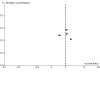
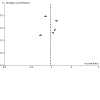
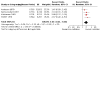

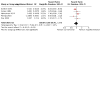
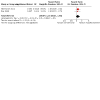
Update of
-
External beam radiation dose escalation for high grade glioma.Cochrane Database Syst Rev. 2016 Aug 19;(8):CD011475. doi: 10.1002/14651858.CD011475.pub2. Cochrane Database Syst Rev. 2016. Update in: Cochrane Database Syst Rev. 2020 May 21;5:CD011475. doi: 10.1002/14651858.CD011475.pub3. PMID: 27541334 Updated.
References
References to studies included in this review
Andersen 1978 {published data only}
-
- Andersen AP. Postoperative irradiation of glioblastoma. Results in a randomized series. Acta Radiologica. Oncology 1978;17(6):475-84. - PubMed
Bleehen 1991 {published data only}
-
- Bleehen NM, Stenning SP, Medical Research Council Brain Tumour Working Party. A Medical Research Council trial of two radiotherapy doses in the treatment of grades 3 and 4 astrocytoma. The Medical Research Council Brain Tumour Working Party. British Journal of Cancer 1991;64(4):769-74. - PMC - PubMed
Glinski 1993 {published data only}
-
- Glinski B. Postoperative hypofractionated radiotherapy versus conventionally fractionated radiotherapy in malignant gliomas. A preliminary report on a randomized trial. Journal of Neuro-oncology 1993;16(2):167-72. - PubMed
Keime‐Guibert 2007 {published data only}
-
- Keime-Guibert F, Chinot O, Taillandier L, Cartalat-Carel S, Frenay M, Kantor G, et al. Radiotherapy for glioblastoma in the elderly. New England Journal of Medicine 2007;356(15):1527-35. - PubMed
Kristiansen 1981 {published data only}
-
- Kristiansen K, Hagen S, Kollevold T, Torvik A, Holme I, Nesbakken R, et al. Combined modality therapy of operated astrocytomas grade III and IV. Confirmation of the value of postoperative irradiation and lack of potentiation of bleomycin on survival time: a prospective multicenter trial of the Scandinavian Glioblastoma Study Group. Cancer 1981;47(4):649-52. - PubMed
Malmstrom 2012 {published data only}
-
- Malmstrom A, Gronberg BH, Marosi C, Stupp R, Frappaz D, Schultz H, et al. Temozolomide versus standard 6-week radiotherapy versus hypofractionated radiotherapy in patients older than 60 years with glioblastoma: the Nordic randomised, phase 3 trial. Lancet Oncology 2012;13(9):916-26. - PubMed
Phillips 2003 {published data only}
-
- Phillips C, Guiney M, Smith J, Hughes P, Narayan K, Quong G. A randomized trial comparing 35 Gy in ten fractions with 60 Gy in 30 fractions of cerebral irradiation for glioblastoma multiforme and older patients with anaplastic astrocytoma. Radiotherapy and Oncology 2003;68(1):23-6. - PubMed
Prados 2001 {published data only}
-
- Prados MD, Wara WM, Sneed PK, McDermott M, Chang SM, Rabbitt J, et al. Phase III trial of accelerated hyperfractionation with or without difluoromethylornithine (DFMO) versus standard fractionated radiotherapy with or without DFMO for newly diagnosed patients with glioblastoma multiforme. International Journal of Radiation Oncology, Biology, Physics 2001;49(1):71-7. - PubMed
Roa 2004 {published data only}
-
- Roa W, Brasher PM, Bauman G, Anthes M, Bruera E, Chan A, et al. Abbreviated course of radiation therapy in older patients with glioblastoma multiforme: a prospective randomized clinical trial. Journal of Clinical Oncology 2004;22(9):1583-8. - PubMed
Shin 1985 {published data only}
-
- Shin KH, Urtasun RC, Fulton D, Geggie PH, Tanasichuk H, Thomas H, et al. Multiple daily fractionated radiation therapy and misonidazole in the management of malignant astrocytoma. A preliminary report. Cancer 1985;56(4):758-60. - PubMed
Walker 1978 {published data only}
-
- Walker MD, Alexander E, Hunt WE, MacCarty CS, Mahaley MS, Mealey J, et al. Evaluation of BCNU and/or radiotherapy in the treatment of anaplastic gliomas. A cooperative clinical trial. Journal of Neurosurgery 1978;49(3):333-43. - PubMed
References to studies excluded from this review
Ali 2018 {published data only}
Buckner 2006 {published data only}
-
- Buckner JC, Ballman KV, Michalak JC, Burton GV, Cascino TL, Schomberg PJ, et al. Phase III trial of carmustine and cisplatin compared with carmustine alone and standard radiation therapy or accelerated radiation therapy in patients with glioblastoma multiforme: North Central Cancer Treatment Group 93-72-52 and Southwest Oncology Group 9503 Trials. Journal of Clinical Oncology 2006;24(24):3871-9. - PubMed
Deutsch 1989 {published data only}
-
- Deutsch M, Green SB, Strike TA, Burger PC, Roberston JT, Selker RG, et al. Results of a randomized trial comparing BCNU plus radiotherapy, streptozotocin plus radiotherapy, BCNU plus hyperfractionated radiotherapy and BCNU following misonidazole plus radiotherapy in the postoperative treatment of malignant glioma. International Journal of Radiation Oncology, Biology, Physics 1989;16(6):1389-96. - PubMed
Fulton 1984 {published data only}
-
- Fulton DS, Urtasun RC, Shin KH, Geggie PH, Thomas H, Muller PJ, et al. MIsonidazole combined with hyperfractionation in the management of malignant glioma. International Journal of Radiation Oncology, Biology, Physics 1984;10(9):1709-12. - PubMed
Guedes de Castro 2017 {published data only}
-
- Guedes de Castro D, Matiello J, Roa W, Ghosh S, Kepka L, Kumar N, et al. Survival outcomes with short-course radiation therapy in elderly patients with glioblastoma: data from a randomized phase 3 trial. International Journal of Radiation Oncology, Biology, Physics 2017;98(4):931-8. - PubMed
Hatlevoll 1985 {published data only}
-
- Hatlevoll R, Lindegaard KF, Hagen S, Kristiansen K, Nesbakken R, Taorvik A, et al. Combined modality treatment of operated astrocytomas Grade 3 and 4. A prospective and randomized study of misonidazole and radiotherapy with two different radiation schedules and subsequent CCNU chemotherapy. Stage II of a prospective multicenter trial of the Scandinavian Glioblastoma Study Group. Cancer 1985;56(1):41-7. - PubMed
Ludgate 1988 {published data only}
-
- Ludgate CM, Douglas BG, Dixon PF, Steinbok P, Jackson SM, Goodman GB. Superfractionated radiotherapy in grade III, IV intracranial gliomas. International Journal of Radiation Oncology, Biology, Physics 1988;15(5):1091-5. - PubMed
Marshall 2006 {published data only}
-
- Marshall NE, Ballman KV, Michalak JC, Schomberg PJ, Burton GV, Sandler HM, et al. Ototoxicity of cisplatin plus standard radiation therapy vs accelerated radiation therapy in glioblastoma patients. Journal of Neuro-oncology 2006;77(3):315-20. - PubMed
Payne 1982 {published data only}
-
- Payne DG, Simpson WJ, Keen C, Platts ME. Malignant astrocytoma. Hyperfractionated and standard radiotherapy with chemotherapy in a randomized prospective clinical trial. Cancer 1982;50(11):2301-6. - PubMed
Roa 2015 {published data only}
-
- Roa W, Kepka L, Kumar N, Sinaika V, Matiello J, Lomidze D, et al. International atomic energy agency randomized phase III study of radiation therapy in elderly and/or frail patients with newly diagnosed glioblastoma multiforme. Journal of Clinical Oncology 2015;33(35):4145-50. - PubMed
Sandberg‐Wollheim 1991 {published data only}
-
- Sandberg-Wollheim M, Malstrom P, Stromblad LG, Anderson H, Borgstrom S, Brun A, et al. A randomized study of chemotherapy with procarbazine, vincristine and lomustine with and without radiation therapy for astrocytoma grades 3 and/or 4. Cancer 1991;68(1):22-9. - PubMed
Shapiro 1976 {published data only}
-
- Shapiro WR, Young DF. Treatment of malignant glioma. A controlled study of chemotherapy and irradiation. Archives of Neurology 1976;33(7):494-500. - PubMed
Shin 1983 {published data only}
-
- Shin KH, Muller PJ, Geggie PH. Superfractionation radiation therapy in the treatment of malignant astrocytoma. Cancer 1983;52(11):2040-3. - PubMed
Simpson 1976 {published data only}
-
- Simpson WJ, Platts ME. Fractionation study in the treatment of glioblastoma multiforme. International Journal of Radiation Oncology, Biology, Physics 1976;1(7-8):639-44. - PubMed
Walker 1980 {published data only}
-
- Walker MD, Green SB, Byar DP, Alexander E, Batzdorf U, Brooks WH, et al. Randomized comparisons of radiotherapy and nitrosoureas for the treatment of malignant glioma after surgery. New England Journal of Medicine 1980;303(23):1323-9. - PubMed
Wick 2012 {published data only}
-
- Wick W, Platten M, Meisner C, Feisberg J, Tabatabi G, Simon M, et al. Temozolomide chemotherapy alone versus radiotherapy alone for malignant astrocytoma in the elderly: the NOA-08 randomised, phase 3 trial. Lancet Oncology 2012;13(7):707-15. - PubMed
Additional references
Arvold 2014
Bauman 1994
-
- Bauman GS, Gasper LE, Fisher BJ, Halperin EC, Macdonald DR, Cairncross JG. A prospective study of short-course radiotherapy in poor prognosis glioblastoma multiforme. International Journal of Radiation Oncology, Biology, Physics 1994;29(4):835-9. - PubMed
Brada 1999
-
- Brada M, Sharpe G, Rajan B, Britton J, Wilkins PR, Guerrero D, et al. Modifying radical radiotherapy in high grade gliomas; shortening the treatment time through acceleration. International Journal of Radiation Oncology, Biology, Physics 1999;43(2):287-92. - PubMed
Cairncross 2013
Carapella 2011
-
- Carapella CM, Telera S, Oppido PA. Surgery of malignant gliomas: advances and perspectives. Current Opinion in Oncology 2011;23(6):624-9. - PubMed
DeAngelis 2001
-
- DeAngelis LM. Brain tumours. New England Journal of Medicine 2001;344(2):114-23. - PubMed
Deeks 2001
-
- Deeks JJ, Altman DG, Bradburn MJ. Statistical methods for examining heterogeneity and combining results from several studies in meta-analysis. In: Egger M, Davey Smith G, Altman DG, editors(s). Systematic Reviews in Health Care: Meta-Analysis in Context. 2nd edition. London: BMJ Publication Group, 2001.
Fine 1993
-
- Fine HA, Dear KB, Loeffler JS. Meta-analysis of radiation therapy with and without adjuvant chemotherapy for malignant gliomas in adults. Cancer 1993;71(8):2585-97. - PubMed
Ghose 2010
Higgins 2003
Higgins 2011
-
- Higgins JP, Green S, editor(s). Cochrane Handbook for Systematic Reviews of Interventions Version 5.1.0 (updated March 2011). The Cochrane Collaboration, 2011. Available from handbook.cochrane.org.
Hochberg 1980
-
- Hochberg FH, Pruitt A. Assumptions in the radiotherapy of glioblastoma. Neurology 1980;30(9):907-11. - PubMed
Huang 2015
Langendam 2013
Laperriere 2002
-
- Laperriere N, Zuraw L, Cairncross G. Radiotherapy for newly diagnosed malignant glioma in adults: a systematic review. Radiotherapy Oncology 2002;64(3):259-73. - PubMed
Louis 2007
Macaulay 2015
-
- Macaulay RJ. Impending impact of molecular pathology on classifying adult diffuse gliomas. Cancer Control 2015;22(2):200-5. - PubMed
Meader 2014
Narayanan 2014
-
- Narayanan V, Patel K, Price S. High grade gliomas: pathogenesis, management and prognosis. Advances in Clinical Neuroscience & Rehabilitation 2012;12(4):23-9.
Oh 2011
-
- Oh J, Sahgal A, Sanghera P, Tsao MN, Davey P, Lam K, et al. Glioblastoma: patterns of recurrence and efficacy of salvage treatments. Canadian Journal of Neurological Sciences 2011;38(4):621-5. - PubMed
Parmar 1998
-
- Parmar MK, Torri V, Stewart L. Extracting summary statistics to perform meta-analyses of the published literature for survival endpoints. Statistics in Medicine 1998;17(24):2815-34. - PubMed
Perry 2017
-
- Perry JR, Laperriere N, O'Callaghan CJ, Brandes AA, Menten J, Phillips C, et al. Short-course radiation plus temozolomide in elderly patients with glioblastoma. New England Journal of Medicine 2017;376(11):1027-37. - PubMed
Reddy 2013
-
- Reddy K, Gaspar LE, Kavanagh BD, Waziri A, Damek DM, Ney D, et al. Prospective evaluation of health-related quality of life in patients with glioblastoma multiforme treated on a phase II trial of hypofractionated IMRT with temozolomide. Journal of Neuro-oncology 2013;114(1):111-6. - PubMed
Review Manager 2014 [Computer program]
-
- The Nordic Cochrane Centre, The Cochrane Collaboration Review Manager (RevMan). Version 5.3. Copenhagen: The Nordic Cochrane Centre, The Cochrane Collaboration, 2014.
Schwartzbaum 2006
-
- Schwartzbaum JA, Fisher JL, Aldape KD, Wrensch M. Epidemiology and molecular pathology of glioma. Nature Clinical Practice Neurology 2006;2(9):494-503. - PubMed
Sminia 2012
Stewart 2002
-
- Stewart L, Burdett S, Glioma Meta-analysis Trialists Group (GMT). Chemotherapy for high-grade glioma. Cochrane Database of Systematic Reviews 2002, Issue 4. Art. No: CD003913. [DOI: 10.1002/14651858.CD003913] - DOI
Stupp 2005
-
- Stupp R, Mason WP, Van den Bent MJ. Radiotherapy plus concomitant and adjuvant temozolomide for glioblastoma. New England Journal of Medicine 2005;352(10):987-96. - PubMed
Stupp 2009
-
- Stupp R, Hegi ME, Mason WP, den Bent MJ, Taphoorn MJ, Janzer RC, et al. Effects of radiotherapy with concomitant and adjuvant temozolomide versus radiotherapy alone on survival in glioblastoma in a randomised phase III study: 5-year analysis of the EORTC-NCIC trial. Lancet Oncology 2009;10(5):459-66. - PubMed
Van den Bent 2013
-
- Van den Bent MJ, Brandes AA, Taphoorn MJ, Kros JM, Kouwenhoven MC, Delattre JY, et al. Adjuvant procarbazine, lomustine, and vincristine chemotherapy in newly diagnosed anaplastic oligodendroglioma: long-term follow-up of EORTC brain tumor group study 26951. Journal of Clinical Oncology 2013;31(3):344-50. - PubMed
Visser 2015
-
- Visser O, Ardanaz E, Botta L, Sant M, Tavilla A, Minicozzi P, et al. Survival of adults with primary malignant brain tumours in Europe; results of the EUROCARE-5 study. European Journal of Cancer 2015;51(15):2231-41. - PubMed
Wallner 1989
-
- Wallner KE, Galicich JH, Krol G, Arbit E, Malkin MG. Patterns of failure following treatment for glioblastoma multiforme and anaplastic astrocytoma. International Journal of Radiation Oncology, Biology, Physics 1989;16(6):1405-9. - PubMed
Wen 2010
-
- Wen PY, Macdonald DR, Reardon DA, Cloughesy TF, Sorensen AG, Galanis E, et al. Updated response assessment criteria for high-grade gliomas: response assessment in neuro-oncology working group. Journal of Clinical Oncology 2010;28(11):1963-72. - PubMed
References to other published versions of this review
Publication types
MeSH terms
LinkOut - more resources
Full Text Sources
Other Literature Sources
Medical
Miscellaneous

